Research Article, J Fashion Technol Textile Eng Vol: 10 Issue: 4
Comparative Study between Slasher or Sheet Denim and Rope Denim
Mahbubul Haque Md1*, Fahim Ferdous Shahriar2, Sree Ajoy Krishna Karmakar3, Mehrab Hossain4, Sakhawat Hossain Rizvi5, Abdul Hai Khan6 and Asit Gosh7
1Department of Textile Engineering, Daffodil International University, Dhaka, Bangladesh
2Fabric Merchandiser, JM Resource Co. Ltd, Dhaka, Bangladesh
3Deputy Manager (Dyeing and Sizing), Aaron denim ltd, Savar, Dhaka, Bangladesh
4 MTO-IE, Fakir Apparels Ltd, Dhaka, Bangladesh
5 MTO-IE, Beximco Textile Division, Dhaka, Bangladesh
6Executive Director, Universal Denim Ltd, Dhaka, Bangladesh
7Department of Textile Engineering, Daffodil International University, Dhaka, Bangladesh
Corresponding Author: Mahbubul Haque Md
Department of Textile Engineering, Daffodil International University, Dhaka, Bangladesh
E-mail:drhaque@diu.edu.bd
Received date: 08 March, 2022, Manuscript No. JFTTE-22-53205;
Editor assigned date: 15 March, 2022, PreQC No. JFTTE-22-53205 (PQ);
Reviewed date: 31 March, 2022, QC No JFTTE-22-53205;
Revised date: 08 April, 2022, Manuscript No. JFTTE-22-53205 (R);
Published date: 11 April, 2022, DOI: 10. 4172/ 2329-9568.1000248
Citation: Haque M (2022) Comparative Study between Slasher or Sheet Denim and Rope Denim. J Fashion Technol Textile Eng 10:4.
Abstract
Denim is one of the most important RMG products made from the colored warp and white weft. The warp is colored before sizing in the preparatory processes. There are mainly two important routes of preparatory processes for producing the weaver’s beams e.g. (i) Slasher or sheet denim and (ii) Rope denim. After the production of the weaver's beam, the weaving is the same as usual. It is widely believed that the two routes of making the weaver beam attributes many differences in the ultimate fabric. The work reported in the paper is an analytical comparison of the impact of the two routes on weaving and fabric characteristics. The study was conducted in a reputed denim manufacturing industry located in Dhaka Bangladesh having both slasher and rope denim facilities. It was revealed that in the case of rope the elongation or stretching of warp yarn is more in rope dyeing than that occurs in a slasher. Regarding the method of spinning, it was observed that the elongation of the ring-spun yarns was more than that of open-end spun yarns. It was also observed that the higher the set length the higher was elongation or stretching of the warp yarns. The single warp yarn tension recorded on the loom was found to vary too much for the slasher beam than that obtained from the rope beam. The warp breakage in the loom is more in the slasher beam than that in the rope beam. Due to more breakage in the loom, the fabric quality of slasher beams is slightly inferior to that of rope. The production capacity of rope is almost double or more than that of slashers. The dyeing and washing characteristics of rope denim fabrics are better than that of slasher, which was due to the greater capacity of the dye boxes and dyeing in rope form. In the cases of all other fabric characteristics too, the rope denim is somewhat better than slasher denim. The consumption of water and utilities steam supply, air compressor, etc. are much higher for rope arrangement than the sheet. It seems that the differences are not much significant except dyeing characteristics.
Keywords: Shasher denim, Rope denim, Elongation, Individual warp tension
Introduction
Apparel mainly trousers made from denim is one of the most successful and widely used apparel and industrial products in the world [1]. Denim trousers have long been popular among people of various ages, at present it is regarded as one of the most fashionable dress by the young generations. Though the majority of products are trousers in few cases products like shirts and jackets are made from denim fabric. Denim is probably the only brand or class of fabric where the warp yarn is dyed before weaving and sizing. The major steps adopted in making denim fabric are winding, warping, dyeing & sizing, and weaving. For the dyeing of warp yarn, a very special processing arrangement is incorporated before the sizing section. Another important aspect of denim warp dyeing is that in most cases indigo/vat dye is used while in some cases Sulphur black is used to get black shade. In very few cases a brown color is used. There are mainly two routes of dyeing warp yarns e.g. sheet or slasher dyeing/denim and rope dyeing/denim. The sheet or slasher dyeing is almost the same as traditional warping, sizing, and weaving except that the dyeing section is incorporated before sizing and the whole process (up to sizing) is continuous. The rope dyeing is completely different having lots of stages and the yarns are dyed as a group or rope and after dyeing the yarns are sized in a separate sizing machine [2]. Being denim garments are highly fashionable and popular, competition among manufacturers of fabric and garments is very high. Therefore, buyers are using their all sorts of skill and expertise to ensure that best fabric is acquired in terms of quality and price. It is widely believed in the industry and related fields that the two methods of dyeing warp yarns mentioned above contribute various attributes to the quality and cost of denim fabrics, the two methods of dyeing denim are also a matter of interest among the experts, faculty members, and students. Considering these facts, an attempt has been made in this paper to study and compare the two methods of dyeing denim warp yarns.
The work was carried out in the Aaron Denim Mills Ltd. Situated in narshingdhi dhaka. The data were mainly collected as part of our theses. Thus, the referred two processes differ in making the weaver’s beam; winding, weaving, and subsequent processes are the same. Attempts have been made to find published works related to the topic, it was disappointing to report, so far the authors are concerned very little information was available. It was noticed that there is a large number of works of literature on various aspects of denim e.g. environmental issues, fabric properties, and their performances, and various aspects of denim garments washing, etc. Aggarwal and Balasubramanian all worked on imperfect stretch during sizing and reported that excessive sizing stretch can causes loss in elongation leading to warp breakage [3]. Studied environmental concerns about denim manufacturing reported that green practices do not always create a burden for industry; she added that traditional green practices which have reduced waste and improved business results must now be taken to strategic focus. Did a thesis entitling “Study on Rope denim”, they reported various advantages of rope denim but did not give any quantitative information. Mentioned that a huge amount of water is required in processing denim yarns.
Materials and Methods
As already mentioned, denim is manufactured using two routes of making the weaver’s beam that contains colored warp yarns. There are no differences in weaving, i.e. weaving is carried out in the same looms available in the loom shed. Figure 1 shows the production flow chart. It shows the two routes of making the weaver’s beam.
Slasher or sheet dyeing
Slasher also is widely known as sheet dyeing is the conventional route of making the weaver's beam. According to this process, warp beams are produced as usual. The warp beams are then put (cleel) at the back of the dyeing and sizing machine. The sizing and dyeing machine is much enlarged (length-wise) where the warp sheet is at first dyed in several indigo (for blue)/black dye baths. It is worthwhile to mention here that denim warp yarns are dyed in four broad shades e.g. i. 100% blue, ii. 100% black, iii. Bottoming (inside black and outside blue) and iv. Toping (inside blue and outside black)
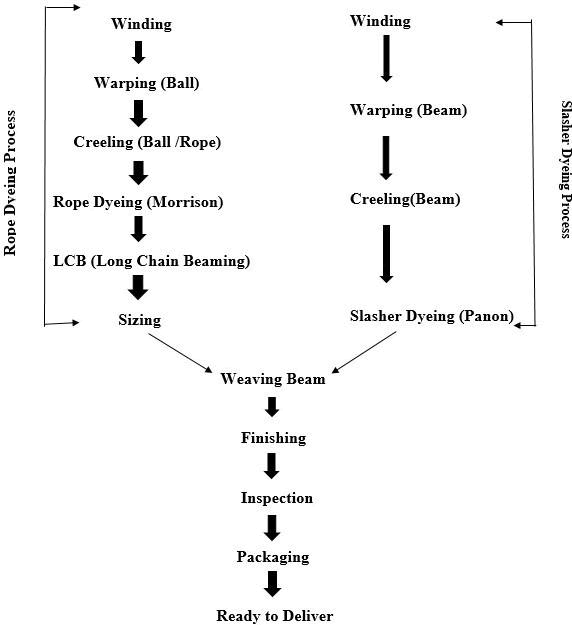
Figure 1: Flowchart of denim manufacturing process.
The dyeing is carried out in 4, 6 or 8 dyeing baths. Initial dye baths are used for indigo dyeing and the last 1or 2 baths are used for Sulphur (black) color. Indigo is a vat dye and is insoluble in water, therefore Na2So4 is used to dissolve the color. During dyeing, the warp yarn enters into the dye bath and comes out and goes upwards for aeration or oxidation which fixes the indigo dye inside the yarn.
This process is repeated several times until a deep shade is reached. In the case of black shade, Sulphur dye is used and the dye is fixed steaming (Figure 2). For this reason, the Sulphur dye baths are equipped with the steam arrangement [4]. After dyeing the sheet of warp yarns is dried by heated cylinders. From the drier, the warp sheet is lead to the sizing section, and after sizing weaver's beams are produced.

Figure 2: Flow diagram of slasher dyeing and sizing.
Rope dyeing
The rope dyeing is another route of making the weaver's beam but completely different from the slasher or sheet dyeing process. Figure 3 shows the flow chart of the processes of rope dyeing. The cones coming from the spinning dept. are at first converted to a cylindrical cross-wound package known as “Balls”, containing 250-430 yarns. This is called ball warping. Lots of balls are then taken to the creel at the backside of the rope dyeing machines.

Figure 3: Flow diagram of slasher dyeing and sizing.
Several balls are dyed at a time, if there are 300 ends in a ball and if there are 4800 ends in the fabric then 4800/300=16 balls have to be used in the rope dyeing. As the creel capacity of rope dyeing is as high as 48 therefore, 16 x 3=48, balls i.e. three sets of warps can be dyed together [5]. The yarns from each ball enter into the dyeing machine as a rope and after dyeing the ropes are collected separately in a large plastic can (Figure 4). The yarns from the cans are then collectively transferred to a large single beam called Long Chain Beam (LCB). The LCB, which would only contain the total number of ends in the final fabric, is then creeled at the back of a conventional sizing machine, and after sizing the weaver’s beams of desired set length are prepared (Figure 5).
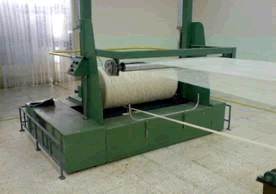
Figure 4: Ball warping.
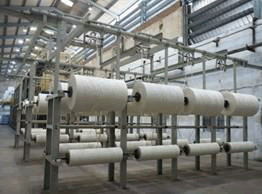
Figure 5: Balls at rope dyeing machine.
Several balls are dyed at a time, if there are 300 ends in a ball and if there are 4800 ends in the fabric then 4800/300=16 balls have to be used in the rope dyeing. As the creel capacity of rope dyeing is as high as 48 therefore, 16 x 3=48, balls i.e. three sets of warps can be dyed together [6]. The yarns from each ball enter into the dyeing machine as a rope and after dyeing the ropes are collected separately in a large plastic can (Figure 6). The yarns from the cans are then collectively transferred to a large single beam called Long Chain Beam (LCB). The LCB, which would only contain the total number of ends in the final fabric, is then creeled at the back of a conventional sizing machine, and after sizing the weaver’s beams of desired set length are prepared.
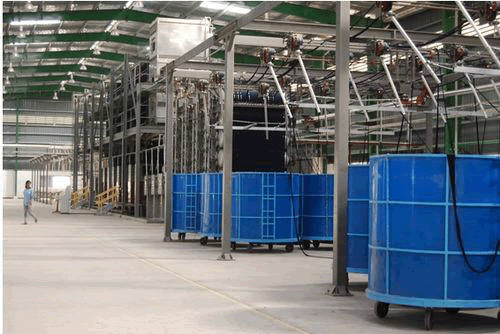
Figure 6: Dyed ropes are collected in large cans.
Weaving process of denim fabric
The weaving of denim is nothing special and the weaves e.g. 2/1, 3/1 twills in few cases 1/1 i.e. plain weave are used. However, the fabric made with plain weave is used for making tops. All kinds of looms e.g. shuttle, projectile, rapier, and air-jet, etc. are used to make denim.
Finishing process of denim fabrics
As can be guessed from the above tables, denim is usually a heavy fabric and is somewhat difficult to sew. The problem becomes more prominent with size materials in it because sizing makes the fabric much stiffer. Hence it would be very difficult to cut and sew this heavy and stiff fabric [7]. Apart from stiffness, denim fabrics possess a natural skewness, which is a fabric fault where the weft does not stay at the right angle with warp yarns, rather a different angle is formed and this occurs due to twill weave. Finally, an attempt is made to eliminate the residual shrinkage in the fabric. Therefore, after weaving the fabric rolls are doffed off, inspected, and passed through a continuous finishing line. Therefore, the objectives of the finishing treatments are i. softening the fabric so that the fabric can cut and sew easily during the apparel making process, ii. To remove the skewness, and iii. To remove the residual shrinkage. The detailed description of the finishing treatments is beyond the scope of this paper. However, the matter has been referred to here because it might have a possible link with the contents of this paper.
Denim washing process
Washing is one of the most important processes of denim garments. Washing adds fashion and value to the garments a lot. The washout effect is achieved by vanishing dyestuff and pigment from fabric to get an exoteric abraded, worn-out look during the washing process.
Numerous types of processes are being used for denim washing and they are broadly categorized as i) Mechanical wash and ii) Chemical wash. There are lots of further classifications but beyond the scope of the present paper.
Results and Discussion
Speed and productivity in the preparatory processes
Table 1 shows detailed information including warping speed for six different warp yarns. It shows that the production speed is much faster in slasher while speed in ball warping is much lower. Though the slasher looks better from a productivity point of view, however, the higher speed in warping is associated with stretching and more breaks in weaving. On the other hand, though the production speed of the rope is lower but the dyeing machine makes everything upside down because the production capacity of rope dyeing is 3-4 times higher than that of slasher or sheet dyeing [8]. Therefore, though the production speed of slasher dyeing machines is higher, even then the overall production capacity of rope dyeing is much higher than slasher. Table 2 also shows the number of warp ends which is higher for rope but can be made much higher than those shown in the table.
*: Can be accommodated up to 48 balls if necessary
Table 1: Comparison between the rope and sheet dyeing (machine speed, ends, and creel capacity).
Elongation (%) of warp in slasher and rope dyeing
To get a better understanding of the two routes of preparing warp beams for weaving, the elongation of the warp yarn was calculated for three different lengths of warp yarns e.g. 11000, 14000 and 16000 meters respectively. In all the cases the initial length and the extended lengths after sizing were recorded. In the case of slasher, the length of the warp beam was considered as the initial length and for rope, the length of the ball warp was considered as the initial length [9]. In both cases, the length of warp yarns in the weaver’s beams after sizing was considered as the extended length. The differences between the two lengths were expressed as a percentage of the initial length and were denoted as elongation%, the individual results can be seen in the following link and a summary of the results are shown in (Table 2).
https://drive.google.com/file/d/1YVii8375fSzM2rz1KetohU6yRjv45SZT/view?usp=sharing
It can be seen that in all cases the elongation was higher in rope dyeing than that in the slasher dyeing. This is probably because rope dyeing is carried using stages e.g. rope dyeing, long-chain beaming, and sizing; and every stage is thought to contribute to some extension while slasher dyeing is a single-stage process. It was also found that elongation % increases as the set length increases [10]. This is probably because; with a longer warp, the initial weight of the warper’s beam/ball is higher, and unrolling this caused extra elongation. It was observed that the elongation % higher for finer yarns; which is probably due to the poor strength of finer yarns. Another important observation in table 3 is that, in all cases, the ring-spun yarn elongated more than open-end yarns.
- Here Elongation Results are included with Rope dyeing (50%), LCB (12%), & Rope Sizing (38%).
- Due to the design of the Ball warping machine, it is not possible to wind beyond 14000 meters in length with the coarser count because at that time the ball becomes very large and touches the ground.
Table 2: Comparison of elongation % of three warping lengths (Metre) in Slasher and Rope sizing.
Performance in the weaving section
Attempts have been made to compare the weaving performance of slasher and rope-dyed warps in the loom. In this regards the warp breakage rate in Centi-Million Picks widely known as CMPX standard was studied and calculated using the following formula.
It may be mentioned that the modern weaving machines automatically memorize the warp breaks and calculates the CMPX. Table 3 shows the CMPX of warp breakages of weaver’s beams originated from slasher and rope-dyeing. It shows that the breakage rate of rope-dyed warp is less than that of slasher-dyed warps. The CMPX data seems somewhat contradictory to elongation values shown in table 3 because the warps that suffer from more elongation are expected to break more on the loom [11]. It is also seen in table 4 that as the linear density decreases the CMPX increases. This is because finer yarns are weaker yarns therefore, they broke more than coarser yarns.
WPB-Warp breakage in Centi-Million Picks,
Table 3: Comparison of warp breakage (CMPX) on the loom between the rope and sheet denim.
Comparison of the distribution of warp tension on the loom between slasher and rope denim
The elongation of warp yarn in the preparatory processes table 3 and the breakage rate in cmpx, (table 4) are somewhat contradictory because normally one would expect to get more breaks for the warp which was elongated more but table 3 shows that the elongation of slasher warp was always slightly lower but the corresponding breakage in the loom was higher for slasher [12]. For further clarification and to apprehend better understanding, it was thought to measure the single yarn warp tension on the loom originated from both slasher and rope dyeing routes. Figures 7 and 8 show the variation of single yarn warp tension on the loom for slasher and rope respectively. The individual readings were also given in the last two tables of the following link https://drive.google.com/file/d/1YVii8375fSzM2rz1KetohU6yRjv45SZT/view?usp=sharing
Each of the figures shows five different curves for five different warp counts e.g. 7/oe, 12/oe, 16/oe, 20/oe, and 30/ring yarns. For each count, 20 readings were taken on the loom with different warps and each horizontal curve shows the variation among 20 readings for the same warps. The average values of 20 readings are shown in table 5. The figures clearly show that the individual warp tension on the loom varied widely in the case of a slasher beam than that of a rope beam. The curves of the rope are relatively flatter which means that the single warp yarns' tension is more uniform in the weaver's beam originated from the rope than slasher [13]. Table 5 also shows that as the linear density of warp yarn decreases the single end warp tension decreases. However, the warp tension (for all counts) is slightly lower in the case rope than the slasher. This is because finer yarns are relatively weaker yarns that need lower tension in the loom.
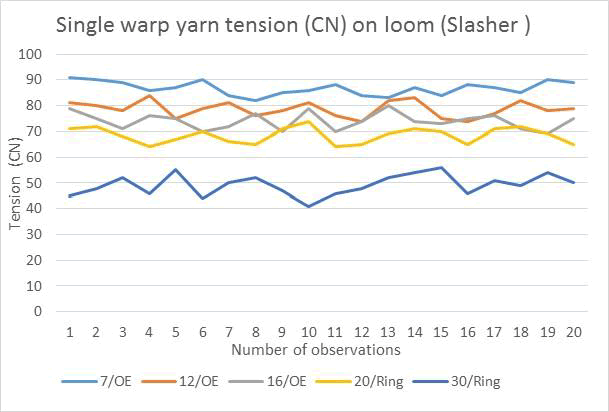
Figure 7: Variation of single yarn warp tension on the loom (Slasher).
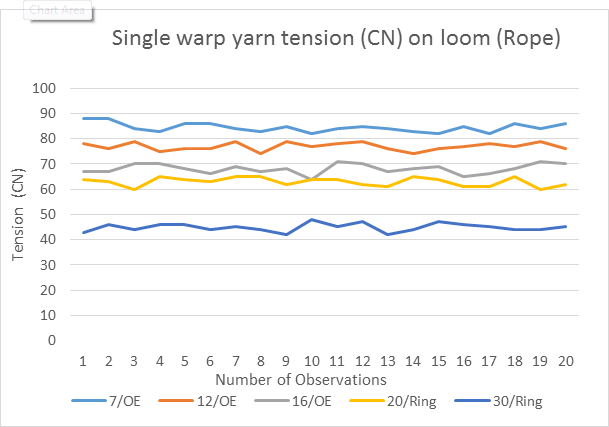
Figure 8: Variation of single yarn warp tension on the loom (Rope).
Table 4: Warp tension on the loom for weaver's beams originated from slasher and rope.
Therefore, two possibilities were proposed for higher warp breakage in the loom having slasher dyed warp beam; i) higher tension of warp which is originated from traditional beam warping process and the variation carried forward up to the weaver’s bean and finally in the loom. Ii) as the warps of the rope dyeing process elongated more; during long chain beaming some of the weak places break and are repaired instantly, as a result, some weak points are eliminated in the lcb. The slasher dyeing is a single and continuous process, at the end of which we get the weaver's beam straightway and there is no possibility of eliminating weak places.
Comparison of fabric inspection report between slasher and rope denim fabrics
The fabric inspection report of the fabrics originated from a slasher and rope denim dyeing was investigated. The inspection was based on a 4-point system and the penalty points were calculated for 100 square yards. Table 5 shows the fabric inspection reports of slasher and rope denim fabrics [14]. The table shows that the penalty points of slasher denim fabrics are slightly higher than that of the rope denim. However, during the discussion with factory experts, it was known that there is no way to differentiate between the fabrics produced from the two routes.
Table 5: Comparison of fabric inspection report between the rope and sheet denim.
Comparison of washing effects between slasher and rope denim fabrics
Some fabric samples were tested for observing the washing effect and shown in Table 6. The table shows that the washing effect is more prominent in the case of rope than slasher [15]. This is probably because some of the dyeing quality of the rope is better than that of the slasher which is due to comparatively larger dye boxes, greater deeping time on and off the rope dyeing.
Table 6: Comparison of washing effect between rope and slasher denim.
Comparison of areas, utilities, water dyes and chemical consumption between slasher and rope denim plants
Table 7 shows that the rope denim system consumes more steam, water, and compressed air as compared to the slasher denim which is due to the large dye box and greater quality of warp is dyed in rope dyeing. The area of rope denim dyeing is slightly greater than that of the slasher denim, this is because there are several processes involved in rope denim dyeing while the slasher is a single process. Table 8 shows water, dyes, and chemical consumption in the two types of denim dyeing processes. The table shows that water, dyes, and chemical consumption in the rope denim dyeing process are higher than that of slasher denim dyeing [16].
*: For 24 ropes, the data will increase for 36 or 48 ropes proportionately
Table 7: Comparison of area and utility consumption between rope and slasher denim plant.
Table 8: Comparison of water, dyes, and chemical Consumption between rope and slasher denim plant.
Comparison of wastes generated between slasher and rope denim production process.
An attempt has been made to gather information about waste % generated in the slasher and the rope denim routes. it was observed that on average 0.9%-1% waste is generated in the slasher dyeing route and 0.6%-0.7% waste is generated in the rope dyeing route(Table 9). The waste % was approximately the same for counts. there were three main reasons for higher waste in slasher were i) at the end of each set some warp is left in the machines which is removed before starting the next set; ii) always, after completion of a set some yarns are left in the warp beams which are mainly due to breakage; iii) sometimes due to faulty measuring system, the length of warp in the different may vary and contribute to waste.
Summary of comparisons between rope and slasher dyeing
Table 9: Wastes generated between slasher and rope denim.
Conclusion
The work reported in the paper is an analytical comparison between the two routes of making denim fabrics. It was realized that after manufacturing the fabric it becomes difficult to separate the fabrics that originated from the two routes, only highly experienced experts can identify the fabric from the two routes. Careful analysis revealed that, for some cases, there are significant differences between the two routes while for some cases there are no differences. The rope-dyed fabric is sold at a higher price. It was found that in the case of rope dyeing, the elongation of warp yarn was more than that occurs in a slasher dyeing. Regarding the method of spinning, it was observed that the elongation of the ring-spun yarns was more than that of open-end spun yarns.
it was also observed that the higher the set length the higher was the elongation or stretching of the warp. The single warp yarn tension recorded on the loom was found to vary too much for the slasher beam than that obtained from the rope beam. it was observed that the warp breakage in the loom was higher in the slasher dyed beam than that in the rope dyed beam. Due to higher breakage in the loom, the fabric quality of slasher beams is slightly inferior to that of rope. The production capacity of the rope dyeing process is 3-4 times that of slashers. The dyeing and washing characteristics of rope denim fabrics are better than that of slasher, which was due to the greater capacity of the dye boxes and relaxation after dyeing in rope form. In the cases of all other fabric characteristics too, the rope denim was somewhat better than slasher denim. The consumption of water and utilities (steam supply, air compressor, etc.) was higher for rope denim than the slasher dyeing process. it seems that the differences are not much significance as far as physical outlook is concerned, apart from that, it is also quite impossible to identify a fabric whether it is made from a slasher beam or rope beam. However, the study reveals that the fabric woven from rope dyeing possesses better quality hence they are sold at a higher price.
References
- Aggarwal SK, Balasuvramanian G (1986) " Effect of stretch on the frequency distribution of breaking elongation of sized yarn and their distribution". Indian J Fibre Text Res 11: 146-149 .
[Crossref], [Google Scholar]
- Dhananjay Devare RN, Turukmane SS, Gulhane Patil LC (2016) "Effect Of yarn stretch in sizing on loom performance". Int j text eng process 2: 4.
[Crossref], [Google Scholar]
- Ramesh N, Narkhedkar PV (2013) "Yarn stretch at sizing decides warp breaks on weaving machines. Melliand Int 19: 215-217.
- " Effect of stretch on the frequency distribution of breaking elongation of sized yarn and their distribution".
- Ejajul H, Faysal GM (2019) "Study on waterless chemical effect on indigo rope dyeing". Int j sci eng res 10: 10.
[Crossref], [Google Scholar]
- Buchanan D, Miller BG, Soutar CA (2003) Quantitative relations between exposure to respirable quartz and risk of silicosis. Occup Environ Med 60: 159-164.
[Crossref], [Google Scholar]
- Si S, Carey RN, Reid A (2016) The australian work exposures study: Prevalence of occupational exposure to respirable crystalline silica. Annal Occup Hyg 60: 631-637.
[Crossref], [Google Scholar]
- Levin K, McLean C, Hoy R (2019) Artificial stone-associated silicosis: Clinical-pathological-radiological correlates of disease. Respirol Case Rep 7: e00470.
[Crossref], [Google Scholar]
- Thakur SA, Beamer CA, Migliaccio CT, Holian A (2009) Critical role of MARCO in crystalline silica-induced pulmonary inflammation. Toxicol Sci 108: 462-471.
[Crossref], [Google Scholar]
- Kumar A, Abdelmalak B, Inoue Y, Culver DA (2018) Pulmonary alveolar proteinosis in adults: pathophysiology and clinical approach. Lancet Resp Med 6: 554-565.
[Crossref], [Google Scholar]
- Nau GJ, Guilfoile P, Chupp GL (1997) A chemoattractant cytokine associated with granulomas in tuberculosis and silicosis. Proc Natl Acad Sci USA 94: 6414-6419.
[Crossref], [Google Scholar]
- Rosenman KD, Reilly MJ, Gardiner J (2010) Results of spirometry among individuals in a silicosis registry. J Occup Environ Med 52: 1173-1178.
[Crossref], [Google Scholar]
- Hoy RF, Baird T, Hammerschlag G (2018) Artificial stone-associated silicosis: A rapidly emerging occupational lung disease. Occup Environ Med 75(1): 3-5.
[Crossref], [Google Scholar]
- McCormic ZD, Khuder SS, Aryal BK, Ames AL, Khuder SA (2010) Occupational silica exposure as a risk factor for scleroderma: A meta-analysis. Int Arch Occup Environ Health 83: 763-769.
[Crossref], [Google Scholar]
- Cooper JH, Johnson DL, Phillips ML (2015) Respirable silica dust suppression during artificial stone countertop cutting. Annal Occup Hyg 59: 122-126.
[Crossref], [Google Scholar]
 Spanish
Spanish  Chinese
Chinese  Russian
Russian  German
German  French
French  Japanese
Japanese  Portuguese
Portuguese  Hindi
Hindi 


